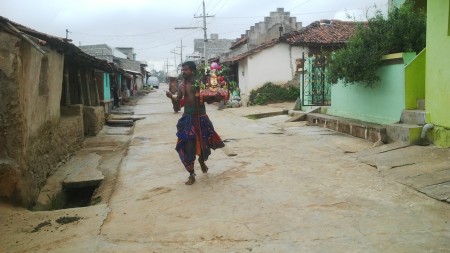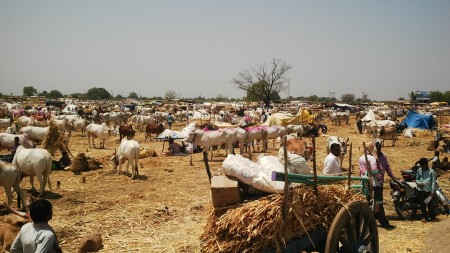In the first part of Voices from the Margins we saw women who appeared courageous and vulnerable at the same time. For men in farming, the picture is not all that bright either. They deal with a multitude of social changes while struggling to sustain their families – change in technology, food, consumption habits as well as family and social relationships, to name a few. Simultaneously, economy and culture in a globalised world alter the perceptions and aspirations of farm families too. In the second part of Voices from the Margins we bring two posts on how cultural practices and social customs in the 21st century often represent and accentuate distress among small holders.
In rural Karnataka, as elsewhere in India, agricultural decisions are often taken with religious interventions. On the new-moon day just before the onset of monsoon many villagers travel to witness the pronouncements by soothsayers on what to sow in their land. Beginning of the harvest season, local deities are generally offered that season’s best harvest. This you will see during winter months in the temples of North-East Karnataka when temple roofs and pillars will be adorned with panicles of sorghum and small bundles of kapas. With new crops in the fields and unknown risks, these offerings now are prayers to guard against disasters like price crash and pests.

It is common to see small family farms trying to emulate agricultural strategies followed by large holders or intensive agribusinesses, despite having very little information on hidden risks. Notwithstanding the risks faced in agriculture, farmers contribute significantly to village festivals. Apart from contributions to the temple jatre, most spend two to three times of their average monthly income on annual rituals for their family deity. Rural families owning large extents of land or with considerable non-farm income often set the tone for such customary expenses too. This influence is seen in the way small holders spend on weddings, funerals, gadgets, alcohol etc. Influence of commercials appearing in all kinds of media makes this race faster and universal than it was a generation ago, despite the fact that this generation of small holders apparently are less endowed with resources and more vulnerable to distress situations.

Gangamma jatre in Reddihalli of Bangalore Rural district is a cultural event both binding and burdening the farmers. This jatre is celebrated every three years if rain fall is normal, otherwise every five years. Expenditure (in 2015 -16) of farmers in this village during the jatre ranged from Rs.5,000 to Rs.15,000 with some spending more than Rs.50,000.

The jatre in Allammaprabhu temple near Kadrapur in Yadgir, is famous for its cattle fair. The Gram Panchayat organises the jatre with donations from villagers. Bustling with people and animals, it showcases bulls from all over the region. In the new format of this jatre, festivities extend to competitions with heavy prize money, like bulls pulling heavy stones. Scores of people from surrounding villages cheer the competing bulls, while media reports critique the treatment meted out to animals. Farmers in these vast dry lands often invest huge amounts in buying and keeping specially chosen breeds of bulls that can pull heavy weight.

A proverb in Kannada – ವೇದ ಸುಳ್ಳಾದರೂ ಗಾದೆ ಸುಳ್ಳಾಗದು (Veda sulladaru gaade sullagadu) – reposes faith in local wisdom, asserting that while even Vedas may err, the gaade (proverbs) won’t. But as the interplay of money, technology and policies traverses national borders, along with the ‘localness’ of culture, conviction and reliance on local knowledge systems also diminish. While disappearance of old social negatives (like exploitation of certain social groups) and emergence of new positive social institutions will be a welcome change, often the reality in rural India is the persistence of old negatives and disappearance of positive institutions that nurtured human values, creativity and ecological wisdom. Amidst the changing cultural milieu of agrarian landscapes and a social structure weak in values and norms, small holders with little information on the invisible claws of the market economy, often end up taking disproportionate financial risks with disastrous consequences.
